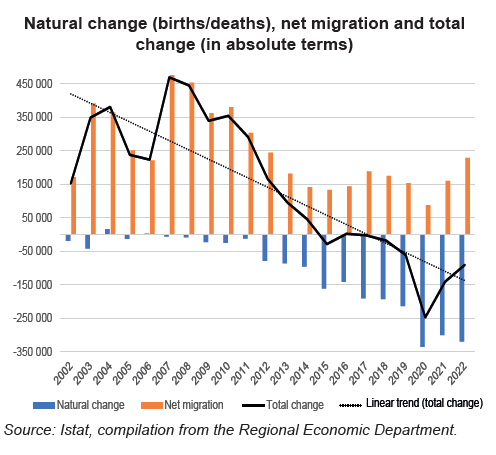Italy and its Demographic Challenge
Italy could see a 20% decline in its population by 2070 as a result of its severe natural decrease. A dwindling and ageing population is hampering GDP growth and putting public finances and public debt sustainability under pressure. Measures – whose outcomes are as yet unclear – have been taken to mitigate the impact of unfavourable demographic trends, while the changes to the pension system for 2024 have yet to be determined.
Italy is the third most populous country in the European Union. After reaching a peak of 60 million in 2014, Italy’s population fell to 59 million in 2022 and could drop to 47 million by 2070. In 2022, while Italy recorded fewer than 400,000 births – the lowest figure since the country’s unification in 1861 – it posted more than 700,000 deaths, the highest level since the 2020 COVID-19 pandemic. Immigration can no longer offset this stark natural decrease.
Italy has a rapidly ageing population: life expectancy, which now stands at 83, has increased by three years since 2000. According to the World Bank classification, Italy has had a “very old population” since 2007, falling into this category three years after Japan and 11 years before France. Ahead by a few years, Italy’s declining population is a harbinger of the EU’s own depopulation by 2030 according to Eurostat projections.
A dwindling and ageing population is hampering GDP growth given changes in (i) the workforce and labour market participation and (ii) investment and productivity in an economy largely formed by family-owned VSEs and SMEs faced with the issue of their hand over.
This “longevity shock” puts pressure on public finances, since it increases the proportion dedicated to pensions, healthcare and long-term care expenditure in the budget. While the percentage of over-65s is growing, that of the workforce is shrinking, raising the risk to the sustainability of public debt which stood at 141.7% of GDP in 2022.
Measures – whose outcomes are as yet unclear – have been taken to mitigate the impact of unfavourable demographic changes: pronatalist policies, labour market reform and selective immigration. Changes to the pension system for 2024 have yet to be determined.
